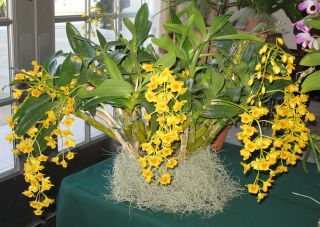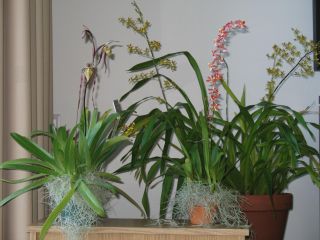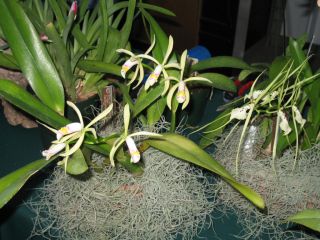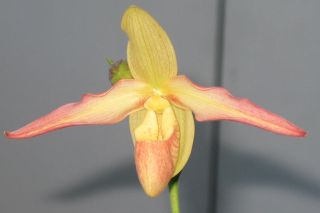Friday found me at the U.S. Botanical Garden eagerly awaiting a class on orchids. Now, I love orchids but I am not at all confident of my ability to keep them happy. The timing of this class was perfect in that I had just added two orchids to my meager collection of four (if you’re counting, we’re up to six!). The two new orchids are not the faithful dendrobium or the considered easy phalaenoposis (see this post).
Arriving early, I spent my time taking some pictures (which I’ll share later). Asking about admission to the class, I was told I could go ahead and seat myself. An empty seat right in front caught my eye and not being shy, I headed that way. After settling my belongings, I hopped up to take pictures of the amazing orchids on display for us.
Our speaker was a Mr. M. Spelta, one of two orchid experts at the botanical garden. Mr. Spelta immediately began conveying information to us in a relaxed way that put us all at ease. New orchids are still being discovered, he told us, and with hybridizing efforts ongoing, our choices of orchids are almost unlimited. We learned that orchids can grow in trees (epiphytes), grow in rocks (lithophytes) and in the ground (terrestrial).
The four most important things to remember regarding orchids are humidity, light, air movement and watering. A humidity tray with rocks was recommended (but don’t let the plants touch the rocks) and we were advised to water approximately once a week, preferably in the morning. Distilled, spring or rain water is best for your orchids, but you can let tap water stand for approximately 30 minutes and then use it. Misting your orchids in the morning is also a good thing. Do not over water your orchids!
Air movement is important for the health of your orchids. Many growers use fans on their orchids. You may also take your orchids outside in warm weather where the natural air movement will be beneficial. Give them some shade as they can burn. Check the leaves and if they feel warm, you need to move them. Horticulture oil was recommended for any insect problems or one teaspoon of dish soap diluted in a gallon of water would also work.
Orchids need light, but not direct sunlight. Dendrobiums can take more light than some other varieties. Phalaenoposis need a ten degree difference in temperature to encourage blooming. It was suggested that putting your phalaenoposis in a window now in the evenings (while the temperatures are still pretty cool) for about two weeks would probably convince them to bloom (if they are not already).
A good fertilizer like Peters or Miracle Grow (
Mr. Spelta graciously answered numerous questions. He also suggested that we call him at the garden with any questions and he would be glad to answer them.
 (This is like one of the ones I just bought! It's fragrant!)
(This is like one of the ones I just bought! It's fragrant!)
After the class, I went back into the orchid habitat and took still more pictures! I’ll post those to follow.
****For more information, check out the American Orchid Society.



























7 comments:
Great post about Orchids. Love them! And now you've gone and bought a fragrant Orchid. Lucky you! What is its name?
Hi yolanda elizabet! I have a smaller Dendrochilum glumaceum 'Virginia'...not so pretty, but the fragrance is nice! When it's cold and dreary out, orchids sure are cheery!
Thanks for coming by!
Great post about orchids. It seems like everytime I post a picture of an orchid in bloom, someone comments that they don't think they have the confidence to grow orchids. If they only knew they aren't that difficult!
Thanks! I was probably in that group until a few years ago when a dendrobium came into my home...and it is still here...in fact, I am going to push the envelope of my confidence and repot it today! Wish me luck!
Good luck!
Thanks for making orchid growing sound less intimidating! The Botanical Gardens look glorious.
Hi doctor mom: They really are, which I can say (lol), since I have exactly nothing to do with it! I'm still in the orchid novice stage, so we shall see...but thanks! I also like collecting, so I fear another plant addiction taking hold....(oh no!)
Hehe, carol...it's on the floor now...stage one!
Post a Comment